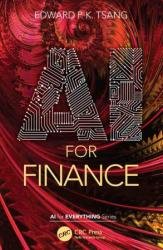AI for Finance
- Добавил: literator
- Дата: 31-03-2023, 01:43
- Комментариев: 0
 Название: AI for Finance
Название: AI for FinanceАвтор: Edward P.K. Tsang
Издательство: CRC Press
Серия: AI for Everything
Год: 2023
Страниц: 126
Язык: английский
Формат: pdf (true)
Размер: 10.2 MB
Finance students and practitioners may ask: can machines learn everything? Could Artifcial Intelligence (AI) help me? Computing students or practitioners may ask: which of my skills could contribute to finance? Where in finance should I pay attention? This book aims to answer these questions. No prior knowledge is expected in AI or finance.
Including original research, the book explains the impact of ignoring computation in classical economics; examines the relationship between computing and finance and points out potential misunderstandings between economists and computer scientists; and introduces Directional Change and explains how this can be used.
To finance students and practitioners, this book will explain the promise of AI, as well as its limitations. It will cover knowledge representation, modelling, simulation and Machine Learning, explaining the principles of how they work. To computing students and practitioners, this book will introduce the financial applications in which AI has made an impact. This includes algorithmic trading, forecasting, risk analysis portfolio optimization and other less well-known areas in finance. Trading depth for readability, AI for Finance will help readers decide whether to invest more time into the subject.
This book aims to explain (1) from the business point of view, where fnance could beneft from AI and (2) from the technology point of view, where AI could contribute to finance.
From the business point of view, AI has rewritten the finance industry for those who have already used AI (those who haven’t been left behind). This book will identify some of the finance operations that could take advantage of research in AI. This includes algorithmic trading, forecasting (Chapter 3), risk analysis (Chapter 4), portfolio optimization (Chapter 5) and data handling (Chapter 6).
From the technology side, Google’s AlphaGo brought Machine Learning to many people’s attention. Can machines learn everything? This book explains the basic principles of Machine Learning and their limitations (Chapter 2). It also explains some of the AI techniques that financial experts could adopt to gain an edge over their competitors who have failed to take advantage of AI developments. This book starts by explaining the synergy between AI and finance: it highlights how fnancial knowledge and AI knowledge could work together to achieve what neither a finance expert nor an AI expert could achieve on their own (Chapter 1).
Google’s stunning success in the boardgame Go ignited worldwide enthusiasm for Machine Learning. It led some to believe that machines can learn anything by themselves. Chapter 2 explains the promise of Machine Learning and the limitation of computation in general. Readers need to understand such limitations and how they impact the basic assumptions of classical economics.
Chapter 3 explains how Machine Learning works. With the help of two financial applications (forecasting and bargaining, a branch of game theory), it explains two classes of Machine Learning, namely “supervised” and “unsupervised” learning.
Chapter 4 explains how modelling, simulation and Machine Learning could be combined to form a powerful tool in finance. This is illustrated in risk assessment, trading strategies design and the design of rules in new markets.
Chapter 5 introduces the portfolio optimization problem.
This book encourages readers to think outside the box: AI is not just about algorithms; knowledge representation is an important part of early AI. Financial researchers and practitioners are all familiar with Time Series. Is Time Series the most natural way to represent time? What is time anyway? This will be explored in Chapter 6.
Chapter 7 briefy covers some of the research that we cannot fit into this short book: algorithmic trading has become a machines-deceiving-machines battle. The signifcance of high-frequency finance is explained. Then it explains that blockchain could provide a lot of opportunities for AI.
Скачать AI for Finance, 1st Edition
[related-news] [/related-news]
Внимание
Уважаемый посетитель, Вы зашли на сайт как незарегистрированный пользователь.
Мы рекомендуем Вам зарегистрироваться либо войти на сайт под своим именем.
Уважаемый посетитель, Вы зашли на сайт как незарегистрированный пользователь.
Мы рекомендуем Вам зарегистрироваться либо войти на сайт под своим именем.
